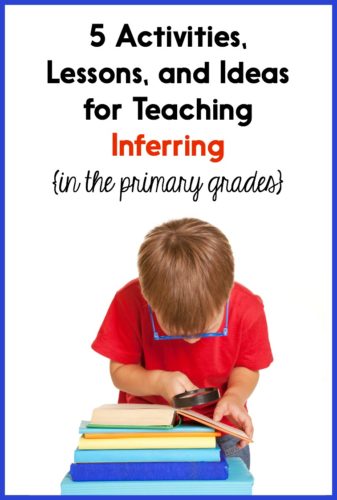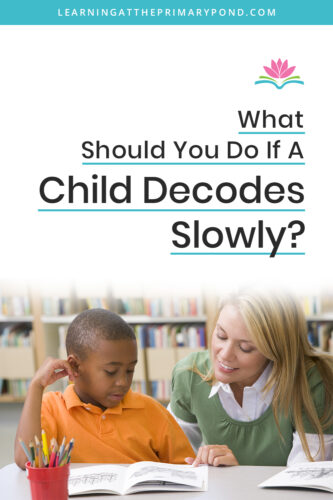Making inferences can be a tricky skill to teach little ones. But here’s the good news – even before you teach a single lesson, your students already know how to infer!
For example, if one of your students enters the classroom crying, the majority of your students will immediately infer that a) their classmate is upset and b) he might want to be comforted. Many children will make this inference instantly, without prompting from an adult.
When we teach our students to make inferences from texts, we need to help them become more aware of that “in-the-head” process that they already do every day in “real life.” Rather than treating inferring as a brand-new skill, we can show our students that they already know how to infer, and then help them use transfer skills to make inferences in texts.
In today’s post, I’ll share ideas for teaching inferring through a gradual release of responsibility. Make sure to read all the way through the post, because there are several different freebies you can download and use right away!

Photo credit: Vitalinka, Shutterstock
Step 1: Making Inferences from Pictures
Before we ask our students to make inferences from texts, they need to know how to make inferences from pictures. This skill is particularly essential for emergent readers.
In the early reading levels, A-D (and sometimes beyond), the pictures do the “heavy lifting” in conveying the meaning of a text. The print is restricted to words that beginning readers can decode, so the pictures play a vital role in developing the plot or providing information.
Even if you teach slightly older students, inferring from pictures is still a great place to start when teaching inferring. Use the kid-safe search engine Kiddle.co or the free stock photo site Pixabay to search for photos to use in this type of lesson.
Here are some search ideas to get you started:
- A sick child
- A happy child at a birthday party
- A worried or scared child
- A broken window
- An animal hunting
- A parent helping a child
Then, try using my FREE inferring lesson with the photos you choose (download it below). When you teach the lesson, keep in mind that it’s more important for children to be able to state what they infer and justify their thinking than it is for them to learn the term “infer” and use it correctly.
Step 2: Making Inferences from Brief Texts
After we’ve practiced inferring from pictures, I like to have my students practice inferring from short texts I read aloud to them. I say something like, “Yesterday we practiced making inferences from pictures – we looked for clues in the pictures that helped us figure things out. Did you know that we can do this with stories and other texts, too? I’m going to read you a paragraph, and I want you to listen quietly. Be a detective and search for clues about what is happening in the story – but don’t shout out! Just show a quiet thumbs-up when you understand what’s happening in the text.”
Then I would read aloud a paragraph that describes an event students would be familiar with (getting ready for lunch, a fire drill, preparing for a field trip, a soccer game, etc.). Click on the image below to download some paragraphs you can use for this activity. (Side note: even if your students can read these paragraphs independently, I recommend that you do the reading so that they can focus only on making inferences.)
 Just as with the picture activity, I want my students to state their inferences and the evidence that “clued them in” – but I don’t require that they use the word “infer.”
Just as with the picture activity, I want my students to state their inferences and the evidence that “clued them in” – but I don’t require that they use the word “infer.”
Step 3: Making Inferences in Connected Text
The picture and paragraph inferring activities aren’t terribly difficult for most children. However, asking students to make connections in complete texts is where the “rubber hits the road.”
As adult readers, we make inferences seamlessly. We’re constantly inferring when we read books and watch movies (although admittedly I am sometimes not so good at inferring during movies and annoy my husband with lots of questions!!).
For children, however, inferring within connected text is very challenging. Sometimes our students make inferences without noticing it. Other times they read right through a page and fail to draw an important conclusion.
It’s so tough for young readers to know when they need to make inferences. And there’s no magic bullet that can solve this problem – we just need to use repeated modeling, appropriate questioning, and provide students with lots of reading practice so that they can begin to master this skill.
If I was going to model making inferences in connected text for the first time, I might say something like, “Boys and girls, we’ve practiced making inferences from clues in photos and in the paragraphs I read aloud to you. Today I’m going to show you how I make inferences while I read the story _________. As I read, I want you to notice how I’m always looking for clues. Because the author does tell me some things about what is going on in the story. But it’s up to me to be a reading detective and figure out certain things that the author doesn’t tell me.”
Then, as I read, I make a t-chart on chart paper to show students how I track my inferences and text evidence (one column says “inferences” and the other column says “evidence”).
Each time I make an inference, I think aloud and point out that the author gives me certain clues but doesn’t always tell me everything. If the text is a longer one, I might read only half of it and then leave the rest for another day, because the think alouds take up a good deal of time.
The next time I pick up the text (or another one), I invite students to help me make inferences. If I find that they’re still struggling, I go back to modeling.
And even if many students are successful with inferring during the read aloud, that doesn’t mean I’m done with the “modeling” part of the gradual release of responsibility. I’ve found that I need to model my inferences repeatedly throughout the year in order for the skill to really stick with students.
Step 4: Having Students Make Inferences from Brief Texts
It’s a big jump between having children infer during read alouds and having them infer while they read independently. To help bridge this gap, you can try giving them short chunks of texts (similar to the paragraphs you read aloud in Step 2).
Before having students read the brief texts and make inferences independently, you’ll want to model this again. You could use a highlighter to show students how you search for clues that help you make the inferences.
If you’d like to try out this activity with your students, click on the image below. You’ll find 3 brief paragraphs in English and the same brief paragraphs in Spanish.
Step 5: Having Students Make Inferences from Longer Texts
At this point, students have watched and listened to you make inferences, as well as helped you make inferences from photos and texts. It’s now time for them to try it on their own.
Students can record their inferences on sticky notes or on t-charts as they read. Click on the image below to download a free inferring t-chart that your students can use:
Conclusions
Even after I ask students to infer independently, I still continue to model and provide guided practice with this skill throughout the year. As the texts students read increase in difficulty, you may notice that they are less successful with inferring (I often see this happen around mid second grade).
Also, although you may spend time focusing just on inferring, it’s a skill that can be easily integrated into other reading units. For example, in fiction, readers can infer:
- How characters are feeling
- Why a character is acting a certain way
- Why the problem in a story is a challenge for a character
In nonfiction, readers can infer:
- Certain information from the photographs or text features
- Why an author is writing about a topic
- What the author’s opinion is on the topic
Something else I want to mention – students who have autism or other learning challenges may struggle with inferring more than other comprehension skills. Students who have autism sometimes have difficulty understanding how characters are feeling, or why they may act a certain way. It may be helpful to work with specialists at your school to find out more about helping these students learn to make inferences.
And here’s another freebie that may be helpful to you – a scope and sequence to show you when I teach inferring and LOTS of other literacy skills! Download the free 1st/2nd grade yearlong literacy scope and sequence at this link!
Looking for more resources to teach inferring and other comprehension skills? Check out reading workshop / shared reading bundles for complete lesson plans and activities for all kinds of reading strategies!
To read more about teaching comprehension strategies, check out these posts:
5 Great Picture Books for Teaching Primary Students to Infer (and Comprehension Questions to Go with Them!)
What Should Comprehension Instruction Look Like in the Primary Grades?
What to Do When Students Don’t Understand What They Read: Tips for Improving Poor Reading Comprehension in K-3
I hope these ideas and freebies are helpful to you! Happy teaching!



















Hi Alison! I loved your post, very informative as always. Do you have any inferring activities in Spanish for K-1 grades? Thanks a lot!
Hi! I just have that last activity in the post that is in both Spanish and English – maybe you could read it aloud to your students and/or have them do it as a class since they are younger?
Alison
Hi Alison,
Thanks to you I gave an excellent lesson on inferring today.
Aw, that’s wonderful! I’m glad it went well! 🙂
Alison
Many thks for the activities. Really made my work easy.
I’m so glad! 🙂
Alison
Thanks a lot.This was realy helped me on my research project
You’re welcome!! 🙂
Alison
Hi there
Do you have any reading comprehension strategy bundles for 2nd, 3rd grade?
Thanks
Fiona
Hi Fiona! I don’t have a reading comprehension bundle, per se, but I do have a reading workshop curriculum for 2nd, as well as a shared reading curriculum (comprehension-focused) for 2nd. You can see those here:
https://www.teacherspayteachers.com/Product/Reading-Workshop-Curriculum-Bundle-for-Second-Grade-1217532
https://www.teacherspayteachers.com/Product/Shared-Reading-and-Written-Response-Curriculum-for-Second-Grade-1211471
Alison
THANK YOU SO MUCH THIS IS VERY TIMELY
Hello
Thank you very much for these wonderful ideas. I teach students who are Deaf and have severe delays with their first language. This breakdown of how to teach inferencing is very doable.I look forward to using these ideas in the new school year.
I’m glad this was helpful! Thanks for reading!!
Alison
thank you for these activities on inference
thank you Alison, is perfect for my boy!
hi
Hi Alice!
This was INSANELY helpful and totally useful for my remote kindergartners, thank you!
Yay! I am so glad!❤️
Very interesting and informative. I reall ejoy.♥️♥️
Yay! I’m so glad! Thanks for stopping by!
I am a Student Teacher. One of my lessons is to teach inferring. The Professors at the University I attend do not teach so I am so glad I have found this information to help me. Thank you! Jody
Glad it helped, Jody!
This worked so well. Thank you for all the helpful hints and free materials.
Great to hear!
Nice one! Very informative and helpful.I love your ideas on how to enhance the skills in making inferences. Thanks a lot and God bless you more…